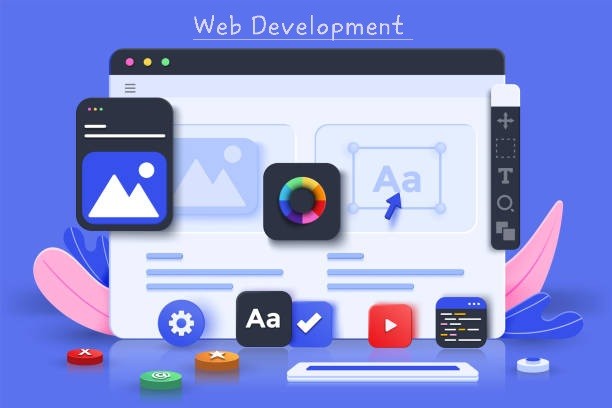In the ever-expanding realm of technology, web development stands as the backbone of the digital frontier. From static web pages to dynamic, interactive platforms, web development has evolved into a multifaceted discipline that shapes the online experiences we encounter daily. In this article, we’ll delve into the intricacies of web development, exploring its foundations, key technologies, and the transformative impact it has on the digital landscape.
Foundations of Web Development
- HTML, CSS, and JavaScript: At the core of web development lie the trio of HTML (Hypertext Markup Language), CSS (Cascading Style Sheets), and JavaScript. HTML provides the structural foundation of a webpage, CSS enhances its visual presentation, and JavaScript introduces interactivity, enabling dynamic and responsive user experiences.
- Front-End Development: Front-end development focuses on the user interface and user experience. Front-end developers work with HTML, CSS, and JavaScript to create visually appealing and interactive websites that users can seamlessly navigate. Frameworks like React, Angular, and Vue.js have become instrumental in building modern, dynamic web applications.
- Back-End Development: Back-end development involves server-side operations, databases, and the logic that powers the functionalities of a website or application. Common back-end languages include Python, Ruby, PHP, and Node.js. Frameworks like Django, Ruby on Rails, Laravel, and Express.js simplify the process of building robust back-end systems.
Key Technologies in Web Development
- Responsive Design: With the proliferation of various devices, responsive web design has become a standard practice. This approach ensures that websites adapt to different screen sizes and resolutions, providing a consistent and optimal user experience across desktops, tablets, and smartphones.
- Application Programming Interfaces (APIs): APIs enable communication between different software systems, allowing developers to integrate third-party services and functionalities into their applications. RESTful APIs, GraphQL, and WebSocket APIs play vital roles in creating connected and interoperable web applications.
- Content Management Systems (CMS): CMS platforms like WordPress, Drupal, and Joomla simplify the process of creating and managing digital content. These systems offer user-friendly interfaces, allowing non-developers to build and maintain websites with ease.
- Cloud Computing: Cloud platforms, such as Amazon Web Services (AWS), Microsoft Azure, and Google Cloud, have revolutionized web development by providing scalable infrastructure, storage, and computing resources. Cloud services facilitate the deployment and maintenance of web applications with greater efficiency and flexibility.
Transformative Impact on Digital Experiences
- E-Commerce Evolution: Web development has played a pivotal role in the evolution of e-commerce. Online shopping platforms, payment gateways, and interactive product catalogs have transformed the retail landscape, offering users seamless and secure shopping experiences.
- Rich Media Experiences: The integration of multimedia elements, such as videos, animations, and interactive graphics, has become a hallmark of modern web development. These features not only enhance engagement but also contribute to immersive storytelling and brand communication.
- Social Connectivity: Social media platforms and social networking functionalities embedded in websites leverage web development to create interconnected digital ecosystems. Features like social sharing, commenting, and real-time updates have become integral components of user engagement.
- Mobile-First Approach: As mobile device usage continues to surge, web development has embraced a mobile-first approach. Websites and applications are designed and optimized for mobile devices, ensuring a seamless and enjoyable experience for users on smartphones and tablets.
Challenges and Future Trends
- Security Concerns: With the increasing complexity of web applications, cybersecurity has become a critical consideration. Web developers must implement robust security measures to protect against threats such as data breaches, SQL injections, and cross-site scripting.
- Progressive Web Apps (PWAs): Progressive Web Apps combine the best of web and mobile applications, providing users with fast, reliable, and engaging experiences. PWAs leverage technologies like service workers to enable offline functionality and push notifications, blurring the lines between web and native applications.
- WebAssembly (Wasm): WebAssembly is a binary instruction format that enables high-performance execution of code on web browsers. It allows developers to write computationally intensive tasks in languages like C++ and Rust, opening up new possibilities for performance-critical web applications.
- Artificial Intelligence (AI) Integration: The integration of AI and machine learning into web development is on the rise. From chatbots that enhance user interactions to personalized content recommendations, AI technologies are adding new dimensions to the user experience.
Conclusion
Web development, at its core, is a dynamic and ever-evolving field that shapes the digital experiences of billions of users worldwide. From the foundational trio of HTML, CSS, and JavaScript to cutting-edge technologies like WebAssembly and AI integration, web development continues to push the boundaries of what is possible in the digital landscape. As we navigate the digital era, the work of web developers remains instrumental in building the platforms and applications that define our online interactions and shape the future of the internet.

